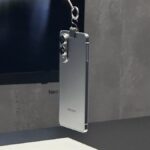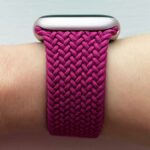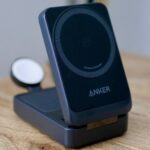JBL Quantum Stream Talk: One-minute review
The real highlight of the JBL Quantum Stream Talk are its design and feature set, which punch above its budget-friendly price point.
It’s super compact and very stylish, with a robust stand that incorporates metal elements to look and feel premium. It’s incredibly easy to adjust and position too, thanks to a small, foam-footed base and a smart swivel mechanism that allows the microphone to be rotated by a full 360 degrees.
The prominent LED ring indicator is a smart inclusion and something that you wouldn’t necessarily expect at this price point, providing a convenient and easy way to check whether the microphone is muted and even adjust some basic settings on the fly.
That said, the recording quality is a let-down out of the box. Its default configuration sounds very jagged and does a poor job of cutting out background noise. Luckily, the compatible JBL Quantum Engine software gives you everything that you need for better recordings. With a few settings tweaked, namely the EQ profile and noise reduction level, it’s perfect for chatting with friends or dialing into meetings – but still not clear enough to rank among the best microphones for streaming.
If you’re interested in picking up a streaming microphone on a budget, there are options out there that look and feel substantially worse, but sound noticeably better such as the AKG Ara. If you can wait for a sale, you can regularly find old favorites like the Blue Snowball for not that much more than the price of the JBL Quantum Stream Talk which offers far more bang for your buck.
JBL Quantum Stream Talk: Price and availability
- Costs $49.95 / £39.99
- Available via Amazon and JBL
- Easy to find in the US and UK
The JBL Quantum Stream Talk is readily available from both Amazon and JBL in the US and UK. It costs $49.95 / £39.99, making this the cheapest entry in the JBL Quantum Stream line right now. At this price, it’s a good value option overall for general use, especially if you’re looking for a more affordable choice that doesn’t take up a lot of space on your desk.
That said, those seeking a microphone for content creation would be better off waiting for a sale and spending a little more on something like the HyperX DuoCast – which routinely drops down to around the $60 / £40 mark and offers higher quality recordings.
JBL Quantum Stream Talk: Specs
| Price | $49.95 / £39.99 |
| Polar pattern | Super cardioid |
| Sample rate | 44.1kHz / 48kHz / 96kHz |
| Bit rate | 16 / 24 bits |
| Frequency range | 50 Hz – 12 kHz |
| Impedance | 16 ohms / 32 ohms |
JBL Quantum Stream Talk: Design and features
- Stylish and compact
- Feels premium
- Good set of features
The JBL Quantum Stream Talk is very stylish for a microphone of its price. It’s compact, with a circular plastic base complete with a small foam ring to help keep it in place on your desk.
It has a simple stalk-like design, with a cylindrical metal column and a small plastic capsule connected by a ball joint that allows it to be rotated a full 360 degrees. Also joining the column and capsule is a short wire with an orange and black braided that introduces subtle splash of color.
At the end of the capsule is a translucent ring illuminated by an LED. This is a bright green by default, turning red when the microphone is muted. The option to dim or even turn off this light would be appreciated, but it’s not particularly intrusive either way.
On the base, you will find a gray JBL logo and an adjustment dial. It’s a good size and can be used to adjust the monitoring headphone volume when you’re connected to a 3.5mm headphone jack on the rear. It can also be pressed down to quickly mute the microphone, or held for a few seconds to adjust the microphone gain – indicated by the mic’s LED turning purple. It’s all very intuitive and one of the biggest reasons to consider the JBL Quantum Stream Talk.
While the microphone itself is a single unit, there is a removable USB-C cable. This is a good 6ft length and feels high-quality, matching the orange and black aesthetic of the wire found on the mic.
While I very much like the integrated stand setup, you should bear in mind that this microphone cannot be mounted to a boom arm unlike other budget picks, so is not suitable if that’s your preferred setup.
JBL Quantum Stream Talk: Performance
- Audio quality isn’t great out of the box
- Sounds much better when you tweak the EQ
- Noise reduction also helps
When you first plug the JBL Quantum Stream Talk into a computer, a popup automatically appears asking whether you would install the compatible JBL Quantum Engine Software – a convenient feature that saves you from having to dig around on a support website to find it. I would highly recommend installing it, as I found that tweaking the microphone’s settings is almost essential.
Out of the box, I was unimpressed with its performance – recordings sounded choppy with a flat, almost nasal quality to them. Booting up Discord for a quick call, background noise was very noticeable, as was any movement of the surface on which the mic was placed. This is a little strange, as the JBL Quantum Stream Talk uses a super-cardioid pickup pattern that should, in theory, really help it hone in on just your voice.
Still, you can achieve decent sound with the JBL Quantum Engine Software in hand. For me, the sweet spot was enabling the “Bright” EQ profile, which bumps up the level of almost every frequency, and turning up both the noise gate and noise reduction settings to medium. Listening back to recordings made with Audacity, my voice sounded a little sharp but otherwise more than ideal for casual chatting. With a few more tweaks, I am sure I could get it to sound even better.
JBL notes that the microphone is compatible with the PlayStation and Nintendo Switch too. Plugging it into my PS5, it provided significantly better sound than the integrated microphone of the DualSense Wireless Controller but is not up to par with any of the mics on the best PS5 headsets. Still, the option to use this model with your console is appreciated and increases its utility somewhat.
That said, this is also marketed as a streaming microphone and I am hesitant to recommend it for that purpose. If you’re able to spend a little more, you can find models that sound better out of the box.
This is doubly true if you’re shopping over a sale period, where the likes of the iconic Blue Snowball routinely have their prices slashed to just $20 / £20 or so more. Still, if your budget really can’t extend beyond the $49.95 / £39.99 mark and you just need something quick, this should just about suffice until you’re able to upgrade.
Should I buy the JBL Quantum Stream Talk?
Buy it if…
Don’t buy it if…
Also consider…
Want to weigh up your options? Here are two gaming microphones to consider alongside the JBL Quantum Stream Talk.
| Row 0 – Cell 0 | JBL Quantum Stream Talk | AKG Ara | HyperX DuoCast |
| Price | $49.95 / £39.99 | $42 / £51 | $99 / £65 |
| Polar pattern | Super cardioid | Cardioid, omnidirectional | Cardioid, omnidirectional |
| Sample rate | 44.1kHz / 48kHz / 96kHz | 96kHz | 96kHz |
| Bit rate | 16 / 24 bit | 24-bit | 16 / 24 bit |
| Frequency range | 50 Hz – 12 kHz | 20Hz – 20kHz | 20Hz – 20kHz |
| Impedance | 16 ohms / 32 ohms | 16 ohms | 32 ohms |
How I tested the JBL Quantum Stream Talk
- Used for over a week
- Tried with PC and console
- Tested with calls and local recording
I used the JBL Quantum Stream Talk as my daily driver for over a week. During that time I tested it with both PC and console with a range of tasks including making calls to friends, recording audio files locally, and attending virtual meetings for work. I made sure to thoroughly test the compatible JBL Quantum Engine software, experimenting with its features to find the best setup.
Throughout my time with the microphone, I compared my experience with my hands-on testing of other models all across the price spectrum ranging from the likes of the Blue Snowball to the Blue Yeti and SteelSeries Alias.
Read more about how we test
First reviewed January 2025.
Read the full article here















